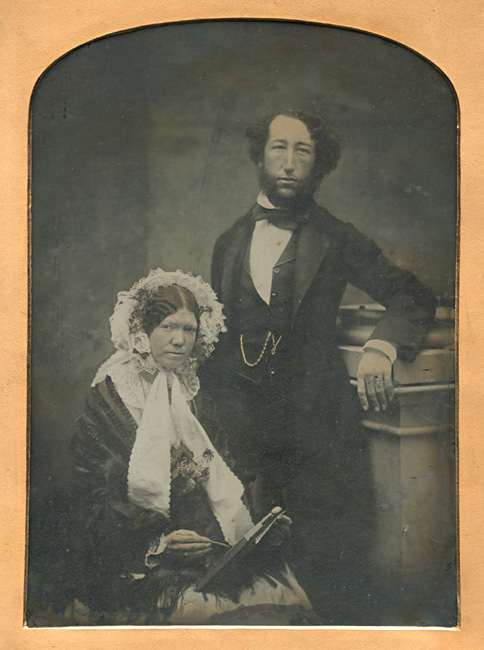It's a charmed coincidence that the ambrotype process can as easily refer to its Greek root, ambrotos ("immortal"), as to James Ambrose Cutting, of Boston, who patented the process in 1854. Either way, the ambrotype was a powerfully popular adaptation of the wet-plate collodion process, creating a positive photographic image on a sheet of glass. Its success lay largely in the simple fact that it was much less expensive to produce than the daguerreotype, although it lacked the appeal of the latter's shiny surface.
Still, often hand-tinted to overcome its grayish-white neutrality, the ambrotype had its moment in the mid-19th century, overtaking the daguerreotype in popularity until it was itself overtaken by the tintype and other processes. Such ambrotypes as the ones in this exhibit--many of them family portraits, all of them among the most portable mementoes of their day--became emblematic of a changing time.
In the U.S. especially, the ambrotype became a poignant artifact of the Civil War, as historian Drew Gilpin Faust notes in her book "The Republic of Suffering", recounting that one of the most highly publicized deaths of the war was that of Amos Humiston, a Yankee soldier who died at Gettysburg and was found with an ambrotype of three children in his hands but no other identification. "The ultimately successful effort to identify him created a sensation, with magazine and newspaper articles, poems, and songs celebrating the devoted father," writes Faust.
The mostly anonymous ambrotypes in this exhibit span the globe, from the U.S. and Latin America to France and Japan, with examples of artful hand-tinting and well-preserved framings, cases and passe-partout mounts. Together, these collectibles portray an especially fecund era of photography, when the affordability and novelty of such processes as the ambrotype led to a profusion of images and a popular rush of self-theatricalization and the whimsical memorializing (even the family dog would become a fair subject for these portraits) of a rapidly vanishing innocence, as the 20th century loomed in the not too far distance. To a one, they are beautiful, evocative objets d'art.
Exhibited and Sold By
Contemporary Works / Vintage Works, Ltd.
258 Inverness Circle
Chalfont, Pennsylvania 18914 USA
Contact Alex Novak and Marthe Smith
Email info@vintageworks.net
Phone +1-215-518-6962
Call for an Appointment














Share This